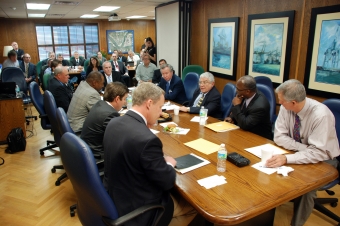Summary:
The activity works legal , economic and strategic aspects related to a complex corporate transaction, from examining of the documents extracted from a real case. The goal is to sensitize students on key questions, sensitive points, the basic concerns of the parties involved, and the main risks and mitigation alternatives. Also, it is searched the identification of the best practices and possible legal vulnerabilities. It is intended to develop in the students the analytical skills and practical skills considered relevant for a business lawyer. The class is divided into groups, which are responsible for analyzing and responding to specific questions formulated by the professor on certain stages or parts of the operation. Additionally, the professor has to stimulate, organize and guide the discussion in the classroom, highlighting in the end the concepts and skills to be assimilated by the students.
Objective:
- GENERAL GOALS: the goal is to develop expertise and skills relevant to the business lawyer, such as the ability to analyze and comprehension of reality, critical sense and questioning attitude, perception of interests and positions, the identification of sensitive questions, strategic vision, teamwork and the spirit of cooperation, creativity and innovation, and the legal reasoning. In addition, the goal addresses several themes in the area.
- SPECIFIC GOALS: from a real case, the goal is to take the student to understand the rationality of a corporate transaction, the main challenges and how to overcome them, culminating in the critical evaluation of the adopted solutions. Skills to be developed by the student:
- Access material and understand practical experience (knowledge not included in academic texts);
- Ability to find simple answers in complex thematic contexts and documentary;
- Recognize conceptual questions in real contexts;
- Handle documentation of corporate transactions;
- Understand the logic that operates behind these types of legal acts.
Dynamics:
- Method: simulation in the classroom and inductive method (from the particular to the general, from real to abstract) to address concepts related to the class and its legal framework. - Professor requirements: the professor selected the case and the corresponding documentation. Lately, he divided the class into groups in which each material would be worked because it was a very extensive corporate transaction. Also, he prepared a series of guiding questions about the case and concept for each group. From the questions, each group prepared specific answers.
- Class requirements: previous reading of selected doctrinal texts and consultation to the case material. Mandatory previous reading for classes that developed the activity consisted on: (1) Instruction CVM nº 319; (2) Guidance Opinion CVM nº 34; (3) Guidance Opinion CVM nº 35; (4) BOTREL, Sérgio. Fusões & Aquisições. São Paulo: Saraiva, 2012, p. 75-147 (Chapter 2 – Item 2); (5) Relevant fact published on 03/19/2007; (6) Market Communication 04/19/2007; (7) Relevant fact published on 12/11/2007; (8) Evaluation report of Deutsche Bank; (9) Evaluation report of Credit Suisse; (10) Evaluation report of APSIS; (11) Evaluation report of KPMG; (12) Merger Protocol and Justification signed between de Petróleo Ipiranga S.A. refinery and Ultra Participações S.A. (13) Writing reports AGE Ultrapar and RIPI; (14) Prospectus of the operation reported by Ultrapar (Topics: Questions and Answers about the transection, and Executive Summary); (15) RIBEIRO, Renato Ventura. Incorporação de companhia controlada. In: WARDE JR., Walfrido Jorge. (coord.). Fusão, cisão, incorporação e temas correlatos. São Paulo: Quartier Latin, 2009, 101-128.
Complementary reading for classes that develop the activity consisted on: (1) EIZIRIK, Nelson. Incorporação de ações: aspectos polêmicos. In: WARDE JR., Walfrido Jorge. (coord.). Fusão, cisão, incorporação e temas correlatos. São Paulo: Quartier Latin, 2009, p. 77-99; (2) GRECO, Marco Aurélio. Reorganização societária e planejamento tributário. In: CASTRO, Rodrigo R. Monteiro de; ARAGÃO, Leandro Santos (coord.). Reorganização societária. São Paulo: Quartier Latin, 2005, p. 29-49.
- DEVELOPMENT OF THE DYNAMICS: in the beginning of the class, the professor distributed the material to be used by students. The exercise should be solved within four hours. 1. The class began with a presentation of the case by the professor to contextualize the exercise. Thus, he explained the exercise and the formation of the groups. 2. Students could consult the materials of the corresponding case. 3. In groups, the students looked for answers to the questions set by the professor to the case of the segment they were analyzing. 4. Further, each group was called to respond verbally to the questions proposed. 5. During a group presentation, the others were paying attention because the debate could help them improve their responses. 6. During the presentation the professor made interventions, clarifying and correcting the answers. The other students were also able to participate.
- END OF THE DYNAMICS: By the end of class, the professor made a closure, highlighting the most important lessons learned in relation to the case presented in this class.
Evaluation:
The dynamics requires that the student returns immediately, because the activity takes place in his very classroom. The answer was part of the participation grade. It was required the personal attendance during the dynamic of the class.
Observation:
The exercise was designed to overcome dynamics in which a part of the group would be alienated. For this, the segments of the event – even if different - have thematic relevance to all groups.
It also responds to the fact that many exercises are thought relying on the previous preparation and reading material provided by the students, although in practice this does not always happen. Thus, the exercise is limited to space and classroom time, and has the advantage of requiring student participation and involvement in the classroom during the time they are in class. Still, each meeting has a scheduled literature that must be studied by the student previously. There is an additional care about the deepening of questions to be answered by the students. The professor should thoroughly review the case to measure the level of response, prepare the questions in order to relate with the concepts discussed and verify if the delivered material is enough.
The exercise works very well for students from the lato sensu courses.
Copyright from the cover page image (cropped):
Image: "Fotos produzidas pelo Senado", available by the Flicker user "Senado Federal", photographer: "Pedro França/Agência Senado", sob a licença Creative Commons BY 2.0






